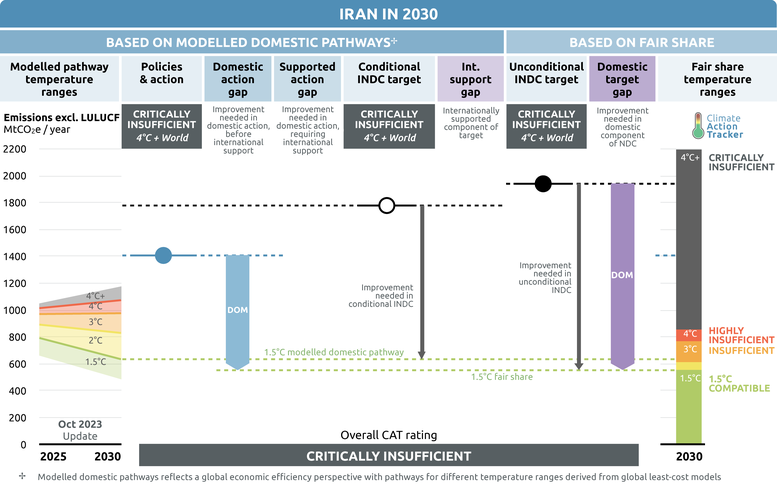Targets
Target Overview
As of October 2023, Iran has signed but still has not ratified the Paris Agreement, meaning its climate pledge remains ‘intended’. In its Intended Nationally Determined Contribution (INDC) released in 2015, Iran pledges to reduce emissions by 4% (unconditional reduction) or 12% (conditional reduction) below business as usual (BAU) by 2030. Based on our calculations, this would translate to an unconditional reduction of 81 MtCO2e and a conditional reduction of around 240 MtCO2e compared to BAU in 2030. The INDC does not provide a BAU which makes it very difficult to assess. In the absence of a clear reference, we use the 2025 BAU provided in the Third National Communication. Values between 2026–2030 are calculated with a five-year trend from emissions growth in 2021–2025.
The INDC mentions various unquantified measures to reach the unconditional pledge, including the development of combined cycle power plants, renewable and nuclear energy, as well as a reduction in gas flaring and energy efficiency measures in end-use sectors.
With international support in the form of finance, technology transfer, and capacity building, the target could be increased to 12% of emissions reductions below BAU by 2030. However, the INDC states that both the conditional and unconditional pledges are subject to an absence of international sanctions.
All greenhouse gases are covered under the INDC, and it seems the target is economy-wide, including emissions from LULUCF, although this is not explicitly specified.
| IRAN — Main climate targets |
|---|
| 2030 unconditional NDC target | ||
|---|---|---|
| Formulation of target in NDC | Iran will mitigate its GHGs emission in 2030 by 4% compared to the BAU scenario. | |
|
Absolute emissions level in 2030 excl. LULUCF |
1940 MtCO2e [145% above 2010] |
|
| Status | Submitted on 19 November 2015 | |
| 2030 conditional NDC target | ||
|---|---|---|
| Formulation of target in NDC | Iran will mitigate its GHGs emission in 2030 by 12% compared to the BAU scenario | |
|
Absolute emissions level in 2030 excl. LULUCF |
1778 MtCO2e [125% above 2010] |
|
| Status | Submitted on 19 November 2015 | |
| Net zero & other long-term targets | ||
|---|---|---|
| Formulation of target | Iran does not have a net zero target, nor has it submitted a long-term strategy (LTS) to the UNFCCC, as of October 2023. | |
|
Absolute emissions level in 2050 excl. LULUCF |
N/A | |
| Status | N/A | |
NDC Updates
At the time of this assessment, Iran has not yet ratified the Paris Agreement.
Target development timeline & previous CAT analysis
CAT rating of targets
The CAT rates Iran’s conditional target as “Critically Insufficient” against modelled domestic pathways. Iran’s conditional target pledges an emissions reduction of 12% below business as usual, which would lead to emissions increasing by around 125% compared to 2010 levels.
The “Critically insufficient” rating signals minimal to no action and is not at all consistent with the 1.5°C temperature limit. If all countries were to follow Iran’s approach, warming would exceed 4°C.
The CAT rates Iran’s unconditional target as “Critically Insufficient” against its fair share range. Iran’s unconditional target pledges an emissions reduction of 4% below business as usual in 2030. The CAT estimates this would lead to emissions increasing by around 145% above 2010 levels.
The “Critically insufficient” rating signals minimal to no action and is not at all consistent with the 1.5°C temperature limit. Iran’s unconditional target is not in line with any interpretation of a fair approach to meeting the 1.5°C limit. If all countries were to follow Iran’s approach, warming would exceed 4°C.
Further information on how the CAT rates countries (against modelled pathways and fair share) can be found here.
Net zero and other long-term target(s)
As of October 2023, Iran does not have a net zero target, nor has it submitted a long-term strategy (LTS) to the UNFCCC.
Further analysis
Latest publications
Stay informed
Subscribe to our newsletter







